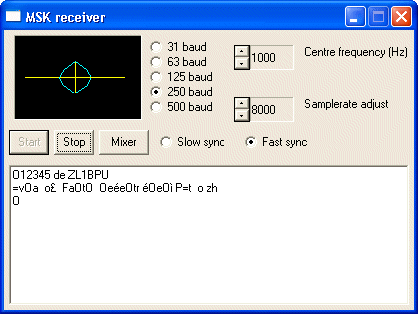MSK is very similar to PSK, but instead of changing the phase to signal data bits, the frequency is advanced or retard a very small amount, sufficient to exactly achieve a 180° phase shift in one bit period. The spectrum is virtually the same as PSK, but the phase relationship between the carrier and the data is different. MSK is little used on HF, but has been widely used on LF, notably (at 100 baud and 200 baud) for DGPS beacons, and (at 50 baud and 100 baud) for VLF submarine communications.The HUGE advantage of MSK over PSK is that the transmitter need not be linear. Two sets of experimental programs are offered: one with no error coding, and one with NASA R=1/2 K=7 convolutional coding. The text source coding uses the G3PLX Varicode also used for PSK31. In all respects apart from the FEC coding, the programs operate identically. The software uses separate transmit and receive programs, which can be operated at the same time, for monitoring your own transmissions or operating in full duplex.
Baud rates from 31.25 to 500 baud are offered. The transmitted tone and default receiver centre frequency is 1kHz. The receiver includes an eye diagram tuning display (thanks to Peter Martinez G3PLX). The programs are very simple - fully functional, but without the features users have come to expect for PSK31 etc. The purpose of these programs was to demonstrate the effectiveness of MSK, especially on LF.

The transmitter programs have across the top a set of radio buttons used to select the operating speed. To the right are the Turn On (TX) button which starts the transmitter, the PTT port button, which brings up a dialog for selection of the serial port used to activate the PTT, and the Output button which opens the Windows Volums Control applet to allow the transmitter power level to be set.Anything you type in the small text window will be transmitted. To the right of this box is a transmit buffer bit counter.

At the top left is a small window with black background which displays the eye diagram. Tuning is correct when (as in example) the blue pattern (the eye) is centred exactly on the yellow cross. Tuning the receiver up and down moves the eye sideways, while errors in the sampling rate will cause the eye to be displaced vertically or to drift and jump.To the right of the tuning diagram are the speed selector buttons, and to the right of them, the manual tuning (audio pitch) and timing (sample rate adjust) controls. It is generally easier to tune the signal with the receiver, but at low baud rates, the manual adjustment is needed for accurate tuning. You may need to adjust the sampling rate if your sound card and the other guy's sound card have timing differences.
Under the tuning display are buttons for Start (start receiving), Stop (Stop receiving) and Mixer (brings up the Windows Wave In applet for adjusting sound card input from receiver). To the right are a pair of sync selectors. Fast sync works fine most of the time. Slow sync is quite slow, but can be useful with very weak signals (but no help when there is multi-path reception).
Of course received data appears in the big window at the bottom.
One of the disadvantages of the FEC version is that there is ambiguity in the coded data stream, and the software cannot (in this simple version) work out the correct bit order. You might recall that PSK31 uses QPSK for the FEC version, and this results in quite poor performance on HF. There is no equivalent in MSK, and so the data bits (the NASA FEC coded dibits) are transmitted sequentially. As a result, the receiver does not know which bits are pairs, and a Slip button is provided to slip the data one bit. If the text appears to be rubbish, press this button and wait for good text. Obviously, in a fully featured version of the software this function would be automatic, and achieved by decoding both bit orders and selecting the one with the best Confidence metric.
- Download:
- MSK transmitter and receiver (no FEC)
- MSK transmitter and receiver with FEC